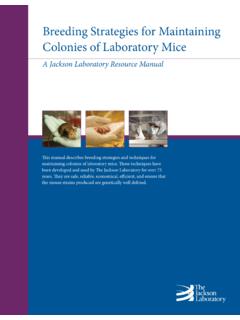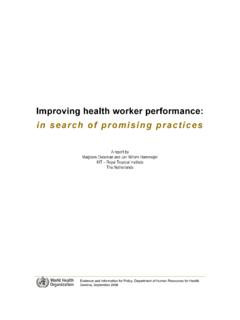Transcription of ANIMAL WELFARE AND DAIRY CATTLE PRODUCTION …
1 2021 OIE - Terrestrial ANIMAL Health Code - 19/07/20211C H A P T E R 7 . 1 1 .A N I M A L W E L F A R E A N D D A I R Y C A T T L E P R O D U C T I O N S Y S T E M SArticle CATTLE PRODUCTION systems are defined as all commercial CATTLE PRODUCTION systems where the purpose of theoperation includes some or all of the breeding, rearing and management of CATTLE intended for PRODUCTION of chapter addresses the WELFARE aspects of DAIRY CATTLE PRODUCTION DAIRY CATTLE PRODUCTION systemsDairy CATTLE in commercial PRODUCTION may be kept in housed or pastured systems, or a combination of are systems where CATTLE are kept on a formed surface, indoors or outdoors.
2 And are fully dependent onhumans to provide for basic ANIMAL needs such as food, shelter and water. The type of housing will depend on theenvironment, climatic conditions and management system. The animals may be housed unrestrained or tethered,within this housing are systems where CATTLE live outdoors, and have some autonomy over diet selection, water consumptionand access to shelter. Pastured systems do not involve any housing except that required for systemsThese are systems where CATTLE are managed in any combination of housed and pasture PRODUCTION systems, eithersimultaneously, or varied in accordance with weather or physiological state of the (or measurables) for the WELFARE of DAIRY cattleThe following outcome-based criteria, specifically ANIMAL -based criteria, can be useful indicators of ANIMAL should also be given to the design of the system and ANIMAL management practices.
3 The use of theseindicators and their appropriate thresholds should be adapted to the different situations where DAIRY CATTLE aremanaged. These criteria can be considered as a tool to monitor the impact of design and management, given that bothof these can affect ANIMAL behaviours could indicate an ANIMAL WELFARE problem. These include decreased feed intake, alteredlocomotory behaviour and posture, altered lying time, altered respiratory rate and panting, coughing, shivering andhuddling, excessive grooming and the demonstration of stereotypic, agonistic, depressive or other OIE - Terrestrial ANIMAL Health Code - 19/07/2021 Chapter ANIMAL WELFARE and DAIRY CATTLE PRODUCTION rateMorbidity rates, including for infectious and metabolic diseases, lameness, peri-partum and post-proceduralcomplications and injury rates, above recognised thresholds, may be direct or indirect indicators of the animalwelfare status of the whole herd.
4 Understanding the aetiology of the disease or syndrome is important for detectingpotential ANIMAL WELFARE problems. Mastitis, and hoof, reproductive and metabolic diseases are also particularlyimportant ANIMAL health problems for adult DAIRY cows. Scoring systems, such as for body condition, lameness andmilk quality, can provide additional clinical examination and pathology should be utilised as an indicator of disease, injuries and other problemsthat may compromise ANIMAL and culling ratesMortality and culling rates affect the length of productive life and, like morbidity rates, may be direct or indirectindicators of the ANIMAL WELFARE status.
5 Depending on the PRODUCTION system, estimates of mortality and cullingrates can be obtained by analysing death and culling and their temporal and spatial patterns of and culling, and their causes, should be recorded regularly, daily, monthly, annually or with referenceto key husbandry activities within the PRODUCTION is useful in establishing the cause of in body weight, body condition and milk yieldIn growing animals, body weight changes outside the expected growth rate, especially excessive sudden loss, areindicators of poor ANIMAL health or ANIMAL WELFARE . Future performance , including milk yield and fertility, ofreplacement heifers can be affected by under- or over-nutrition at different stages of lactating animals, body condition outside an acceptable range, significant body weight change and significantdecrease in milk yield may be indicators of compromised non-lactating animals and bulls, body condition outside an acceptable range and significant body weight changemay be indicators of compromised efficiencyReproductive efficiency can be an indicator of ANIMAL health and ANIMAL WELFARE status.
6 Poor reproductiveperformance, compared with the targets expected for a particular breed, can indicate ANIMAL WELFARE may include: anoestrus or extended post-partum interval, low conception rates, high abortion rates, high rates of dystocia, retained placenta, metritis, loss of fertility in breeding appearancePhysical appearance may be an indicator of ANIMAL health and ANIMAL WELFARE , as well as the conditions ofmanagement. Attributes of physical appearance that may indicate compromised WELFARE include: presence of ectoparasites, abnormal coat colour, texture or hair loss, excessive soiling with faeces, mud or dirt (cleanliness), swellings, injuries or lesions, discharges ( from nose, eyes, reproductive tract), feet abnormalities, abnormal posture ( rounded back, head low), emaciation or responsesImproper handling can result in fear and distress in CATTLE .
7 Indicators include: evidence of poor human- ANIMAL relationship, such as excessive flight distance, negative behaviour at milking time, such as reluctance to enter the milking parlour, kicking, vocalisation,Chapter ANIMAL WELFARE and DAIRY CATTLE PRODUCTION systems2021 OIE - Terrestrial ANIMAL Health Code - 19/07/20213 animals striking restraints or gates, injuries sustained during handling, such as bruising, lacerations, broken horns or tails and fractured legs, animals vocalising abnormally or excessively during restraint and handling, disturbed behaviour in the chute or race such as repeated reluctance to enter.
8 Animals slipping or from common proceduresSurgical and non-surgical procedures may be performed in DAIRY CATTLE for facilitating management, improvinghuman safety and ANIMAL WELFARE ( disbudding, hoof trimming), and treatment of certain conditions ( abomasum). However, if these procedures are not performed properly, ANIMAL WELFARE can becompromised. Indicators of such problems could include: post procedure infection, swelling and pain behaviour, reduced feed and water intake, post procedure body condition and weight loss, morbidity and good WELFARE of DAIRY CATTLE is contingent on several management factors, including system design,environmental management, and ANIMAL management practices which include responsible husbandry and provision ofappropriate care.
9 Serious problems can arise in any system if one or more of these elements are recommendations for measures applied to DAIRY recommendation includes a list of outcome-based measurables derived from Article does not excludeother measures being used where on system design and management including physical environmentWhen new facilities are planned or existing facilities are modified, professional advice on design in regards to animalwelfare and health should be aspects of the environment can impact the WELFARE and health of DAIRY CATTLE . These include thermal environment,air quality, lighting, noise, environmentAlthough CATTLE can adapt to a wide range of thermal environments particularly if appropriate breeds are used forthe anticipated conditions, sudden fluctuations in weather can cause heat or cold ) Heat stressThe risk of heat stress for CATTLE is influenced by environmental factors including air temperature, relativehumidity, wind speed, ANIMAL density (area and volume available per ANIMAL )
10 , shade availability, animalfactors including breed, age, body condition, metabolic rate and stage of lactation, and coat colour handlers should be aware of the risk that heat stress poses to CATTLE and of the thresholds in relationto heat and humidity that may require action. As conditions change, routine daily activities that require movingcattle should be amended appropriately. If the risk of heat stress reaches very high levels the ANIMAL handlers42021 OIE - Terrestrial ANIMAL Health Code - 19/07/2021 Chapter ANIMAL WELFARE and DAIRY CATTLE PRODUCTION systemsshould institute an emergency action plan that gives priority to access to additional water and could includeprovision of shade, fans, reduction of ANIMAL density, and provision of cooling systems as appropriate for thelocal measurables: feed and water intake; behaviour, especially respiratory rate and panting;physical appearance, especially dehydration; morbidity rate; mortality rate.














